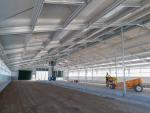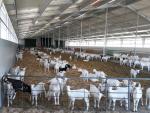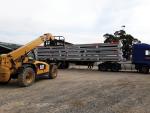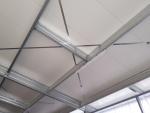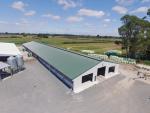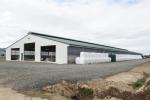Aztech: Building a Rural Goat Farm That Helps Increase Production
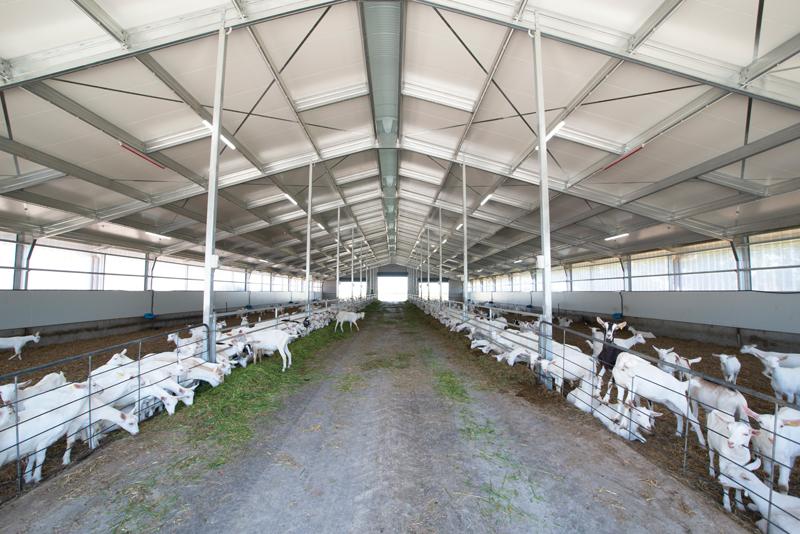
With 35 years of experience of farming goats, Frans Janssen knows how important it is for good milk production to keep the animals comfortable and healthy.
So when he wanted to expand his Waikato goat farming operation, Elite Goat Milk, at Manawaru, just south of Te Aroha, he set his sights on building the best sheds possible for his animals.
And that meant working in collaboration with Hamilton-based Aztech Buildings, who specialise in dairy goat sheds as part of their wider operations of designing and constructing industrial, rural and lifestyle buildings.
To maximise milk production, the sheds have to be laid out efficiently and have insulated roofs for climate control so the goats remain at a comfortable, even temperature.
Metalcraft’s 50mm thick ThermoSpan EPS roof panels were chosen for the roof because of their robustness, insulation values and ease of installation. The panels consist of a 0.59mm profiled roofing sheet bonded to an EPS core with a ceiling panel sheet bonded to the underside in a choice of colours for both sides.
“Before I came to New Zealand, I had 25 years of farming goats in Holland so we were very familiar there with these sorts of sheds with insulated roof panels,” said Frans.
“The panels keep the heat out and they help to get rid of condensation so the barns are drier, and you don’t get as much noise inside when it rains – the goats are happier and healthier and it’s a nicer environment for staff to work in as well.
“It’s all about creating the right conditions for the goats to get the best out of production and to be the best for animal welfare.”
The goats are kept in the sheds following a zero grazing principle, which means that grass is cut for them and, along with other feed and supplements, brought to them in the barn’s feeding area. They also have a bedding area and still have access to outdoor areas for sunlight, and the sheds have partial walls to allow for ventilation.
Frans added three new sheds to the four already on site at the farm he has owned for just over a year. The sheds are all 25m wide but of varying lengths: 106m, 102m and 60m.
His old sheds are a mixture of wooden frame with steel roof and steel frame with canvas roof.
He said the difference between the old sheds and the new sheds is “like night and day” when it comes to milk production and comfort.
Frans’ expansion of his operation to 3000 goats comes as demand for goat milk increases dramatically due to its use in infant formula for children who are intolerant of dairy products.
Daniel Prestidge, of Aztech Buildings, which has been designing and building goat sheds since 2005, said demand for the barns has grown in the past 10 years as goat milk formula has become more commercialised, driven largely by the Dairy Goat Cooperative.
Daniel said the design of the barns is customised for each farm depending on where they can be sited, how much space there is, and the access to and availability of existing infrastructure. There also has to be the right balance between feeding and bedding areas to maximise production.
“The barns also have to be designed to operate efficiently in both summer and winter, and to deal with storms and rain,” Daniel said.
“Dairy goats need an even temperature to maintain optimum production. Big fluctuations can cause disease like pneumonia. If they get too hot they put all their energy into keeping cool and its milk production drops like a stone,” he said. “They are also very susceptible to disease outside and generally perform poorly outside whereas in a barn they are comfortable and healthy and their feed can be controlled.
“In broad terms, a well-designed barn will double their milk production.”
Daniel said Aztech’s purpose-built sheds were a perfect fit for Frans’ operation, being durable and cost-effective.
“Frans’ new barns are considered market-leading but he has been prepared to invest in them and in time they will prove their value not just with the increased production from the goats but the fact that they will last and perform well over a long time.”
Terry Stevenson, of Metalcraft Insulated Panels, said, “Our story begins with an approach by Aztech Buildings early last year to quote for 50mm insulated panels for the roofs of new 60m and 102m x 25m wide goat sheds, with a 15-degree roof pitch.
“In conjunction with Aztech Buildings staff we set about formulating manufacture and delivery times to meet this large order as with limited site space, a good plan was essential.
“The team at Aztech Buildings decided upon our ThermoSpan EPS 50mm panels, and for us working out the correct lengths including a rebate for the gutter became easy thanks to their high-quality and detailed drawing suite.”
The ThermoSpan roof panels have a 1000mm cover, so the 102m goat shed required 102 panels per side (totalling 204 panels), and the 60m shed needed 60 panels each side (totalling 120 panels). Each 50mm R1.31 panel is 13.11m in length, with ‘Permanent Green’ colour to the top and ‘Titania’ on the ceiling side.
Terry added, “Producing more than 4km of panel in between regular customers of Metalcraft Insulated Panels involved considerable planning at the Manukau factory. But that wasn’t the only requirement, as 100mm thick ThermoPanels laid horizontally at 1200mm high were specified for the full building lengths, permitting ventilation on both sides.
“Our production manager is top notch and made sure we had enough COLORSTEEL® coil on deck and managed to fit the order amongst our normal production runs.
“I visited the site numerous times during installation and after the 102m shed was finished I spoke to the farmer, Frans Janssen, who said that straight away he noticed the kid goats were a lot calmer inside their new buildings. I understand that goats are highly sensitive to their environment and it became clear that our ThermoSpan roof helped his animals.”
And Metalcraft Insulated Panels were called on again when Frans decided later on to add the third shed – at 106m long.
Terry said, “It took a massive back-office effort to get our panels made and to site on the exact day they were required, and, not without a couple of hiccups, our team achieved that. I really enjoyed working with the Aztech team; we always knew where they stood throughout the build process which meant we were working off the same page.”


